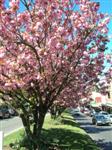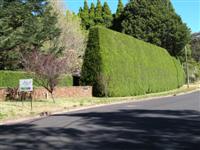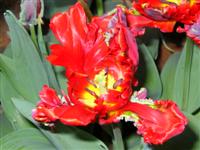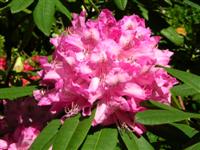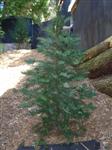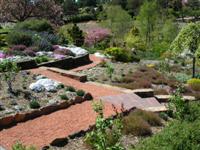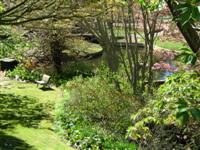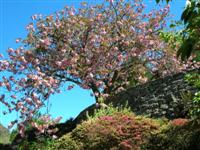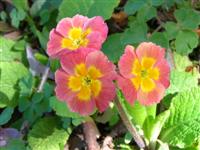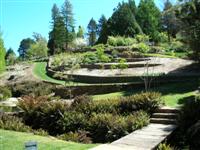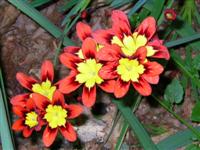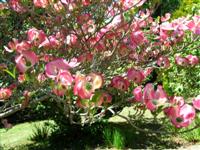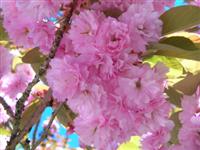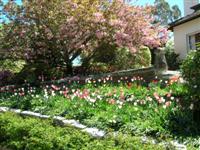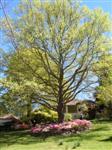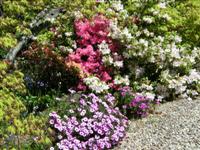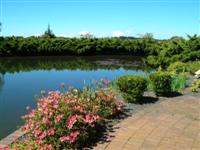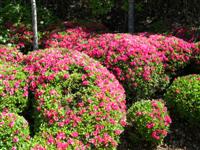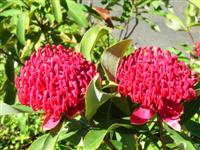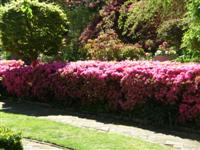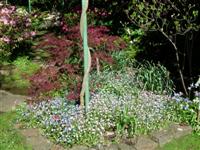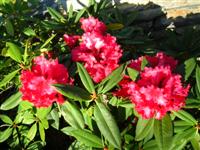|
|
| Main Street, Leura Image © David Powell, 2006 |
|
|
| Now that's a hedge! Image © David Powell, 2005 |
|
|
| Tulip, Shenstone Image © David Powell, 2006 |
Anyway, that's the background. Now for the gardens. The hard part is picking which of the over 300 beautiful photo's I took to include on this page! The 2006 Festival included 9 gardens. They ranged from an elaborate spread that covered several acres to little gardens on 1/4 acre blocks.
Shenstone
The first garden we visited was one of the little gardens on 1/4 acre blocks, the home of the Roscoe's and it was a mass of colour .. lots of tulips ... and so many different varieties and colours .. not just the classic goblet-shaped variety. The gardens (and house) date back to 1919 and have been in the Roscoe family for over 60 years. Other features of the garden are the grove of fruit trees (citrus, apple & another 8-9 varieties) and several Sorenson built stone walls (the Blue Mountains is littered with Sorenson walls - Irish style stone walls built without mortar). The roses date back to the 1950's. Included in the many shrubs, trees and flowers are Arabis', Camellias, Clematis, Pansies, Ranunculus, Alpine Phlox, berry fruit bushes, an olive grove, Azaleas, a Magnolia, Rhododendrons and much more.
|
|
|
|||
| Alpine Bed Image © David Powell, 2006 |
Shenstone's Gardens Image © David Powell, 2006 |
Shenstone's Gardens Image © David Powell, 2006 |
|
|
|
|||
| Useful wheelbarrow Image © David Powell, 2006 |
Tulip Image © David Powell, 2006 |
Shenstone's Gardens Image © David Powell, 2006 |
|
|
| Wollemi Pines, The Braes Image © David Powell, 2006 |
The next was the huge spread, the jewel of the crown if you like .. complete with a stream and several lakes. It's still in construction, but what's there is pretty impressive. The high point was the collection of Wollemi pines .. trees thought extinct for over 200 million years and only rediscovered in the 1990's. When the first clones were sold to the public, at auction, the owner of this garden got trees 1,2 and 7 .. at a total cost of over $50,000 .. for seedlings! They're about a metre high now. If he can afford 4 full time gardeners, I guess he can afford that! Lots of trees and landscaped terraces, a natural spring and heaps more. The original core of the garden is over 60 years old and contains several extensive Sorenson stone walls. Some wonderful flower specimens, including a terrace full of beds, but the forte of this property is its collection of trees and shrubs. Not to mention its lush lawn that'd put any golf course to shame! The entrance overlooks the terraced garden beds, beneath which is a stream leading into one of the many lakes. On the far side is the start of a grove of newly planted Maples. A path follows the natural watercourse, pass Swamp Cypress and lots of Dogwoods, in various colours (not just the usual white), all in full bloom. Several small waterfalls along the watercourse, in their little nooks, full of ferns and mosses. The eastern side of the garden, still in its early stage, will be a Japanese garden. Following the creek to its end, one comes to spring fed lake, complete with a group of Kookaburra's which were optimistically fishing in the water, along with a few waterfowl. Lots of Rhododendrons, Azaleas and flowering cherries.
|
|
|
|||
| Terraces, The Braes Image © David Powell, 2006 |
Terraces, The Braes Image © David Powell, 2006 |
Spring-fed Lake Image © David Powell, 2006 |
|
|
|
|||
| Dogwood & Sorenson wall Image © David Powell, 2006 |
Flowers Image © David Powell, 2006 |
Terrace & stream from below Image © David Powell, 2006 |
Rustlings
This garden was landscaped with a subtle Japanese theme. There was a tea house snug in one corner, but nothing else overtly Japanese, still one came away with the distinct impression. For part of the tour I was behind an elderly Japanese couple and they seem most appreciative of the garden, so it t'was evidently a realistic impression. The property and gardens date to the 1920's, although the garden in its present form was established in the 1960's and is currently being renovated. The previous two gardens gave an impression of openness, with lots of sunshine. Rustlings in contrast was much more intimate, full of shadows and dim nooks, tho' the centre of the property was in full sun and a series of terraced beds of tulits and other colourful flowers in full bloom - some 4000 spring flowering bulbs add lots of colour to this garden. The entrance to the garden is beneath a large Wisteria arbour. The path leads past Camellias, Buxus and Lavender before heading into a shadowly rainforest landscape with a stream, bridge, small ponds and ferns, along with Pieris, Azaleas and various Rhododendrons. There're also Liquidambars, Maples a Claret Ash, Myrtle Hedge, Magnolias, a huge Oak tree and a Rose Arbour. In the centre is a mass of colour with Tulips, Sparaxis, Bluebells and Azaleas.
|
|
|
|||
| Shaded Azaleas in bloom Image © David Powell, 2006 |
Japanese Tea House Image © David Powell, 2006 |
Flowers Image © David Powell, 2006 |
|
|
|
|||
| Cynthia & Tulips Image © David Powell, 2006 |
Tulips Image © David Powell, 2006 |
Blooming Dogwood Image © David Powell, 2006 |
Brabourne
This property dates back to the 1920's and were designed and created by Paul Sorensen. Stone walls and pathways are typical Sorenson. It was named Brabourne in 1944 by the then owner's wife in memory of her birthplace back in England. The overall impression of this property is of brighness, openness and of course, colour. Very much like a park. The driveway is colourful lined with carpet roses, blue and white Anemones, daffodils and tulips, along with a spectacular flowering cherry ‘Kanzan’ that seems to reach everywhere. Along the Sorenson path to the back of the property with a giant Pin Oak, as well as Liquidambars, Golden Elm, Dogwoods, Copper Beech, a Tulip tree and Maples. Spring bulbs edge pathways along with lots of azaleas. Bluebells, yet more Azaleas and Lily of the Valley. Not to forget the white and pink flowering cherries. The Pin Oak out the back and the huge cherry in the front are without doubt the most outstanding feature.
|
|
|
|||
| Cherry 'Kanzan' & house Image © David Powell, 2006 |
Cherry blooms closeup Image © David Powell, 2006 |
Azaleas Image © David Powell, 2006 |
|
|
|
|||
| Cherry tree & Tulips Image © David Powell, 2006 |
Giant Pin Oak Image © David Powell, 2006 |
Colourful driveway Image © David Powell, 2006 |
The Gate House
This property seemed plain .. but only in contrast to the others on the tour. In defense, while the property and gardens are around 40 years old, the present owners are in the process of extensively renovating the gardens with lots of new plantings that will, one day, create a mature garden rivalling the others on the tour. The Gate House is also the only garden on the 2006 tour that featured a lot of natives.
|
|
|
|||
| Flower bloom Image © David Powell, 2006 |
Flowers Image © David Powell, 2006 |
The Gardener Image © David Powell, 2006 |
Fairmont
Fairmont is a golf club resort. The impression here is of grand formality, very much different from most of the other gardens on the tour. Beds and beds of shaped azaleas, with a variety of colours. There are also three sizable lakes, all well stocked with giant Koi carp, hungily crusing around looking for a free feed - stand at the lake shore and you'll soon have a school of colourful Koi hoping for a handful of bread. Tho' with many of them reaching 2 foot, you'd need more than a handful of bread to keep them happy. Plenty of waterfowl and lots of water lilies. As well as the azaleas, there're also Juniper, Dogwoods, Silver Birches, Tupelos and prehistoric Australian Cycads. Joining two of the lakes was a waterfall, flanked by treeferns, ferns and Gymea Lilies. A final surprise were the waratahs in the car park.
|
|
|
|||
| Lake & reflections Image © David Powell, 2006 |
Lake & Junipers Image © David Powell, 2006 |
Fairmont gardens Image © David Powell, 2006 |
|
|
|
|||
| Waterfall & ferns Image © David Powell, 2006 |
Koi Carp Image © David Powell, 2006 |
Azaleas Image © David Powell, 2006 |
|
|
|
|||
| Colourful tree blooms Image © David Powell, 2006 |
Gazebo & lake Image © David Powell, 2006 |
Waratahs Image © David Powell, 2006 |
Nurung
Another beautiful cottage garden. Nurung was part of the first festival in 1965, but this year is its first appearance in over 30 years, having fallen on less than ideal times in between. The new owners have restored the garden to it's former glory and added an ecclectic range of statues and sculptures throughout, tho' one of the most interesting things was not part of the garden - the family car .. one of those tiny things that zip around the inner city. The central feature of the garden is a huge bronze sculpture and fountain, full of mythological motifs. Lots of azaleas (they seem to be Leura's 'national' flower) and an extensive flower bed full of colour and curiously shaped rocks. Lots of topiary and a Wisteria arbour. The moss-covered path was quite a comfortable walk.
|
|
|
|||
| Azaela hedge Image © David Powell, 2006 |
'Giant something' Image © David Powell, 2006 |
Wisteria Arbour Image © David Powell, 2006 |
|
|
|
|||
| Mossy stone Image © David Powell, 2006 |
Sculpture Fountain Image © David Powell, 2006 |
Shaped stones & flower bed Image © David Powell, 2006 |
Ewanrigg
Very ingeniously designed - this garden is landscaped on a standard sized block of land, yet it has terraces with a variety of trees. Ewanrigg has been a regular in the festival for the past 40 years. One is amazed at just how much can be crammed into one block, yet not appear overcrowded, albiet this garden certainly doesn't have the park-like openness of some of the others. Near the front a weeping larch and old Japanese weeping maples are surrounded by tulips. To the rear there's a copper beech and Albertiana spruce, bordering on the golf course. To the side of the house is a small stream and a graceful stone bridge. A trellis covered by very mature wisteria which sadly looks like someone has recently taken to it with an axe and almost severed the trunk. Nearby are other trees and many colourful flowers, as well as a very lush lawn. Heaps of Azaleas, Rhododendrons and Camellias. Even a Tulip Tree.
|
|
|
|||
| Colour Image © David Powell, 2006 |
Mossy Pot Image © David Powell, 2006 |
More Colour Image © David Powell, 2006 |
|
|
|
|||
| Shrubs Image © David Powell, 2006 |
Garden Image © David Powell, 2006 |
Garden Image © David Powell, 2006 |
Bridge Cottage
The last garden on the tour was notable for the small stream flowing thru' it and a quaint, english style bridge, from which it takes it name. Probably the smallest garden on the tour, this one contains a mixture of trees and shrubs, along with the ever present Azaleas and Rhododendrons. Alas, the battery in my camera went flat upon arriving at this garden, so I only managed to get a few photographs. A nice collection of orchids out the back.
|
|
||
| Azaleas Image © David Powell, 2006 |
The Bridge Image © David Powell, 2006 |

With a few hours of light left and a trip into katoomba to get a new camera battery, we stopped by that old standby, the three sisters. Visibility over the Jamison Valley wasn't all that good - a lot of the Blue Mountain's gum tree oil haze, but the sisters were close enuf to get a good, crisp view. No need to say much on them .. if you don't know about them .. do a web search and you'll soon find more than you needed. :) To keep in with the theme, I had to add a nice flower photograph I took in the car park at Echo Point.
|
|
|
|||
| The Three Sisters, from Echo Point Image © David Powell, 2006 |
Echo Point car park Image © David Powell, 2006 |
Mt Solitary & Jamison Valley Image © David Powell, 2006 |
Some web sites of relevance (valid as of October 2006)
Leura Garden Festival: http://www.leuragardensfestival.com.au
Blue Mountains Tourism (Leura): http://www.bluemts.com.au/tourist/towns/leura.asp
Leura Blue Mountains Online: http://www.leurabluemountains.com/
Three Sisters - Wikipedia: http://en.wikipedia.org/wiki/Three_Sisters_(Australia)
Blue Mountains Tourism (Three Sisters): http://www.bluemts.com.au/tourist/thingsToDo/threeSisters.asp
|
|
Text and photographs © David Powell, except where indicated Click on any thumbnail to view larger version |
|
|
